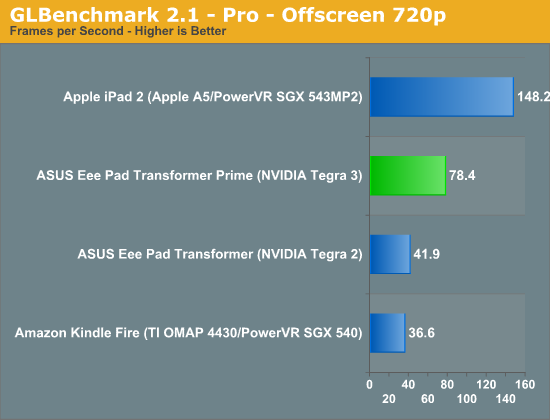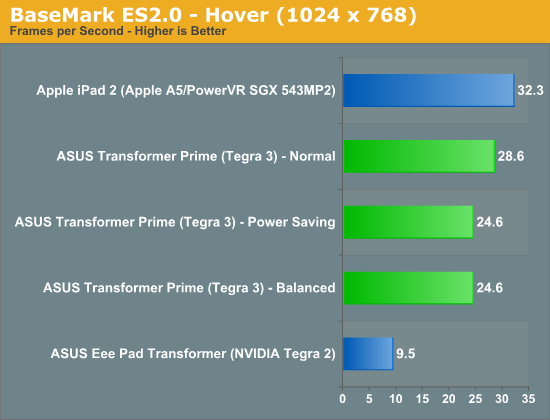ASUS Eee Pad Transformer Prime & NVIDIA Tegra 3 Review
by Anand Lal Shimpi on December 1, 2011 1:00 AM ESTTegra 3 GPU: Making Honeycomb Buttery Smooth
The bigger impact on the overall experience is the Tegra 3's GPU. If you remember back to our initial analysis of Tegra 3 you'll know that the GPU is not only clocked higher but it also has more execution resources at its disposal. To further improve performance, per "core" efficiency is up thanks to some larger internal data structures and tweaks. The end result is much better gaming performance as well as a much smoother UI.
Tasks like bringing up the apps launcher or even swiping between home screens are finally far above 30 fps. While Tegra 2 didn't have the fill rate to deal with some of the more complex overlays in Honeycomb, Tegra 3 does. The move to Tegra 3 makes the Honeycomb experience so much better. This is what it should've been like from the start.
Gaming performance is also significantly better as you can see from our standard collection of Android GPU benchmarks:




Performance is still not quite up to par with the iPad 2, but if we look at GLBenchmark's Egypt test Tegra 3 doesn't do too bad. The gap grows in more texture bound tests but in a heavier shader environment Tegra 3 isn't too shabby. While it's clear that Tegra 2 wasn't enough to deal with the 1280 x 752 resolution of Honeycomb tablets, Tegra 3 seems well matched.
Note that the BaseMark ES2.0 tests run at FP16 on Tegra 2 and 3 vs. FP24 on the PowerVR SGX 543MP2.










204 Comments
View All Comments
metafor - Friday, December 2, 2011 - link
1. The advantages of a companion core apply just as much to single, dual or quad core systems. In each case, individual cores can be power-gated. The companion core is there to provide lower idle power even beyond a single core. So no, going with a dual-core doesn't somehow make a companion core less necessary.2. A15 is huge compared to A9. Huge. Both in area and power. If anything, an A15 SoC needs a companion core even more than anything based on A9.
3. Because A15 is huge, a quad-core in a smartphone form factor isn't very feasible at 32nm. Nor is quad-core really all that useful for the vast majority of use-cases anyway. Especially since A15 performs so much better per-core than an A9.
phantom505 - Thursday, December 1, 2011 - link
Yeah, who can put up with a mere 9 hours of continuous playback. It's so bad....Oh wait...
medi01 - Thursday, December 1, 2011 - link
iPad 25 Wh battery.Galaxy Tab 14.8 Wh battery.
;)
thunng8 - Thursday, December 1, 2011 - link
Why are you comparing the ipad to the 7" Galaxy tab? Of course the ipad will have a bigger battery.quiksilvr - Thursday, December 1, 2011 - link
I was actually surprised too. To be fair, the A5 chip is huuuuge in the iPad, but that doesn't change the fact that it's still beating a quad core setup.My guess is ICS will optimize quad core capabilities more and we'll be seeing a very different picture once that is released.
So I say wait for ICS and then pass judgement.
vision33r - Thursday, December 1, 2011 - link
How is it a surprise? Core i5 can match up against Core i7 in 95% if apps without needing the extra cores.In real world test, the difference between Core i5 and i7 performance is hardly measurable.
name99 - Thursday, December 1, 2011 - link
Of course by the time ICS is actually available on these sorts of devices, iPad3 with A6 will probably be out...Point is: a "my vaporware can beat up your vaporware" contest is generally not very enlightening to anyone.
daveloft - Thursday, December 1, 2011 - link
It has nothing to do with the CPU, it's all about the GPU.medi01 - Thursday, December 1, 2011 - link
Yeah, iPad wins hands down and it's very practical too.Think about encoding video in a browser using javascript, for instance
metafor - Thursday, December 1, 2011 - link
I think a lot of people (including myself) go with Android because we like the additional features provided by the OS -- true multitasking, choice of a plethora of browsers, third party players, no iTunes, Google integration, etc.But yes, iPad 2 has been king of both performance and battery life for a while now.